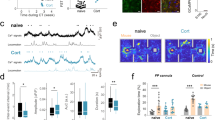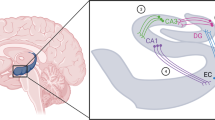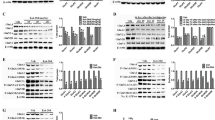Abstract
Depression is usually associated with alterations in the monoaminergic system. However, new evidences suggest the involvement of the glutamatergic system in the aetiology of depression. Here we explored the glutamatergic system in a rat model of depression (i.e., the flinders sensitive line (FSL)) to reveal the mechanism underlying the emotional and cognitive aspects associated with the disease. We showed a dramatically elevated level of baseline glutamatergic synaptic transmission by whole-cell recordings as well as impairment in long-term potentiation induced by high-frequency stimulation in hippocampal slices from FSL rats compared with Sprague–Dawley rats. At behavioural level, FSL rats displayed recognition memory impairment in the novel object recognition test. Enantioselective chromatography analysis revealed lower levels of D-serine in the hippocampus of FSL rats and both synaptic plasticity and memory impairments were restored by administration of D-serine. We also observed dysfunctional astrocytic glutamate regulation including downregulation of the glia glutamate transporter GLAST as shown by western blot. One possibility is that the dysfunctional astrocytic glutamate reuptake triggers a succession of events, including the reduction of D-serine production as a safety mechanism to avoid NMDA receptor overactivation, which in turn causes the synaptic plasticity and memory impairments observed. These findings open up new brain targets for the development of more potent and efficient antidepressant drugs.
This is a preview of subscription content, access via your institution
Access options
Subscribe to this journal
Receive 12 print issues and online access
$259.00 per year
only $21.58 per issue
Buy this article
- Purchase on Springer Link
- Instant access to full article PDF
Prices may be subject to local taxes which are calculated during checkout





Similar content being viewed by others
References
Licinio J, Wong ML . Advances in depression research: 2011. Mol Psychiatry 2011; 16: 686–687.
Nierenberg AA, Husain MM, Trivedi MH, Fava M, Warden D, Wisniewski SR et al. Residual symptoms after remission of major depressive disorder with citalopram and risk of relapse: a STAR*D report. Psychol Med 2010; 40: 41–50.
Reppermund S, Ising M, Lucae S, Zihl J . Cognitive impairment in unipolar depression is persistent and non-specific: further evidence for the final common pathway disorder hypothesis. Psychol Med 2009; 39: 603–614.
Hasselbalch BJ, Knorr U, Kessing LV . Cognitive impairment in the remitted state of unipolar depressive disorder: A systematic review. J Affect Dis 2011; 134: 20–31, In Press, Corrected Proof.
Roiser JP, Sahakian BJ . Relationship between ecstasy use and depression: a study controlling for poly-drug use. Psychopharmacology (Berl) 2004; 173: 411–417.
Austin M-P, Mitchell P, Goodwin GM . Cognitive deficits in depression: Possible implications for functional neuropathology. Br J Psychiatry 2001; 178: 200–206.
Gotlib IH, Joormann J . Cognition and depression: current status and future directions. Annu Rev Clin Psychol 2010; 6: 285–312.
Steffens DC, Otey E, Alexopoulos GS, Butters MA, Cuthbert B, Ganguli M et al. Perspectives on depression, mild cognitive impairment, and cognitive decline. Arch Gen Psychiatry 2006; 63: 130–138.
Kondo DG, Hellem TL, Sung Y-H, Kim N, Jeong E-K, DelMastro KK et al. Magnetic resonance spectroscopy studies of pediatric major depressive disorder. Depress Res Treat 2011; 2011: 650450.
Hashimoto K . Emerging role of glutamate in the pathophysiology of major depressive disorder. Brain Res Rev 2009; 61: 105–123.
Tokita K, Yamaji T, Hashimoto K . Roles of glutamate signaling in preclinical and/or mechanistic models of depression. Pharmacol Biochem Behav 2012; 100: 688–704, In Press, Corrected Proof.
Sanacora G, Zarate CA, Krystal JH, Manji HK . Targeting the glutamatergic system to develop novel, improved therapeutics for mood disorders. Nat Rev Drug Discov 2008; 7: 426–437.
Pittenger C, Duman RS . Stress, depression, and neuroplasticity: a convergence of mechanisms. Neuropsychopharmacology 2008; 33: 88–109.
Santarelli L, Saxe M, Gross C, Surget A, Battaglia F, Dulawa S et al. Requirement of hippocampal neurogenesis for the behavioral effects of antidepressants. Science 2003; 301: 805–809.
Berton O, Nestler EJ . New approaches to antidepressant drug discovery: beyond monoamines. Nat Rev Neurosci 2006; 7: 137–151.
McNally L, Bhagwagar Z, Hannestad J . Inflammation, glutamate, and glia in depression: a literature review. CNS Spectr 2008; 13: 501–510.
Sanacora G, Rothman DL, Mason G, Krystal JH . Clinical studies implementing glutamate neurotransmission in mood disorders. Ann N Y Acad Sci 2003; 1003: 292–308.
Fonken LK, Xu X, Weil ZM, Chen G, Sun Q, Rajagopalan S et al. Air pollution impairs cognition, provokes depressive-like behaviors and alters hippocampal cytokine expression and morphology. Mol Psychiatry 2011; 16: 987–995.
Bruel-Jungerman E, Rampon C, Laroche S . Adult hippocampal neurogenesis, synaptic plasticity and memory: facts and hypotheses. Rev Neurosci 2007; 18: 93–114.
Campbell S, Marriott M, Nahmias C, MacQueen GM . Lower hippocampal volume in patients suffering from depression: a meta-analysis. Am J Psychiatry 2004; 161: 598–607.
Neves G, Cooke SF, Bliss TVP . Synaptic plasticity, memory and the hippocampus: a neural network approach to causality. Nat Rev Neurosci 2008; 9: 65–75.
Airan RD, Meltzer LA, Roy M, Gong Y, Chen H, Deisseroth K . High-speed imaging reveals neurophysiological links to behavior in an animal model of depression. Science 2007; 317: 819–823.
Overstreet DH, Friedman E, Mathe AA, Yadid G . The Flinders Sensitive Line rat: a selectively bred putative animal model of depression. Neurosci Biobehav Rev 2005; 29: 739–759.
Eriksson TM, Delagrange P, Spedding M, Popoli M, Mathe AA, Ogren SO et al. Emotional memory impairments in a genetic rat model of depression: involvement of 5-HT/MEK/Arc signaling in restoration. Mol Psychiatry 2011; 17: 173–184.
Chen Y, Rex CS, Rice CJ, Dube CM, Gall CM, Lynch G et al. Correlated memory defects and hippocampal dendritic spine loss after acute stress involve corticotropin-releasing hormone signaling. Proc Natl Acad Sci USA 2010; 107: 13123–13128.
Ryan B, Musazzi L, Mallei A, Tardito D, Gruber SHM, El Khoury A et al. Remodelling by early-life stress of NMDA receptor-dependent synaptic plasticity in a gene?environment rat model of depression. Int J Neuropsychopharmacol 2009; 12: 553–559.
Colino A, Malenka RC . Mechanisms underlying induction of long-term potentiation in rat medial and lateral perforant paths in vitro. J Neurophysiol 1993; 69: 1150–1159.
Porsolt RD, Le Pichon M, Jalfre M . Depression: a new animal model sensitive to antidepressant treatments. Nature 1977; 266: 730–732.
Broadbent NJ, Squire LR, Clark RE . Spatial memory, recognition memory, and the hippocampus. Proc Natl Acad Sci USA 2004; 101: 14515–14520.
Henneberger C, Papouin T, Oliet SHR, Rusakov DA . Long-term potentiation depends on release of d-serine from astrocytes. Nature 2010; 463: 232–236.
Overstreet DH, Janowsky DS, Gillin JC, Shiromani PJ, Sutin EL . Stress-induced immobility in rats with cholinergic supersensitivity. Biol Psychiatry 1986; 21: 657–664.
Schell MJ, Molliver ME, Snyder SH . D-serine, an endogenous synaptic modulator: localization to astrocytes and glutamate-stimulated release. Proc Natl Acad Sci USA 1995; 92: 3948–3952.
Ridet JL, Malhotra SK, Privat A, Gage FH . Reactive astrocytes: cellular and molecular cues to biological function. Trends Neurosci 1997; 20: 570–577.
Matrisciano F, Caruso A, Orlando R, Marchiafava M, Bruno V, Battaglia G et al. Defective group-II metaboropic glutamate receptors in the hippocampus of spontaneously depressed rats. Neuropharmacology 2008; 55: 525–531.
Glaum SR, Miller RJ . Metabotropic glutamate receptors depress afferent excitatory transmission in the rat nucleus tractus solitarii. J Neurophysiol 1993; 70: 2669–2672.
Markou A, Matthews K, Overstreet DH, Koob GF, Geyer MA . Flinders resistant hypocholinergic rats exhibit startle sensitization and reduced startle thresholds. Biol Psychiatry 1994; 36: 680–688.
Inoue R, Hashimoto K, Harai T, Mori H . NMDA- and beta-amyloid1-42-induced neurotoxicity is attenuated in serine racemase knock-out mice. J Neurosci 2008; 28: 14486–14491.
Balan L, Foltyn VN, Zehl M, Dumin E, Dikopoltsev E, Knoh D et al. Feedback inactivation of D-serine synthesis by NMDA receptor-elicited translocation of serine racemase to the membrane. Proc Natl Acad Sci USA 2009; 106: 7589–7594.
Lucassen PJ, Muller MB, Holsboer F, Bauer J, Holtrop A, Wouda J et al. Hippocampal apoptosis in major depression is a minor event and absent from subareas at risk for glucocorticoid overexposure. Am J Pathol 2001; 158: 453–468.
Zarate C, Machado-Vieira R, Henter I, Ibrahim L, Diazgranados N, Salvadore G . Glutamatergic Modulators: The Future of Treating Mood Disorders? Harvard Rev Psychiatry 2010; 18: 293–303.
Eddleston M, Mucke L . Molecular profile of reactive astrocytes--Implications for their role in neurologic disease. Neuroscience 1993; 54: 15–36.
Gosselin RD, Gibney S, O’Malley D, Dinan TG, Cryan JF . Region specific decrease in glial fibrillary acidic protein immunoreactivity in the brain of a rat model of depression. Neuroscience 2009; 159: 915–925.
Ye Y, Wang G, Wang H, Wang X . Brain-derived neurotrophic factor (BDNF) infusion restored astrocytic plasticity in the hippocampus of a rat model of depression. Neurosci Lett 2011; 503: 15–19.
Banasr M, Chowdhury GM, Terwilliger R, Newton SS, Duman RS, Behar KL et al. Glial pathology in an animal model of depression: reversal of stress-induced cellular, metabolic and behavioral deficits by the glutamate-modulating drug riluzole. Mol Psychiatry 2010; 15: 501–511.
Zink M, Vollmayr B, Gebicke-Haerter PJ, Henn FA . Reduced expression of glutamate transporters vGluT1, EAAT2 and EAAT4 in learned helpless rats, an animal model of depression. Neuropharmacology 2010; 58: 465–473.
Choudary PV, Molnar M, Evans SJ, Tomita H, Li JZ, Vawter MP et al. Altered cortical glutamatergic and GABAergic signal transmission with glial involvement in depression. Proc Natl Acad Sci USA 2005; 102: 15653–15658.
Bechtholt-Gompf AJ, Walther HV, Adams MA, Carlezon Jr WA, Ongur D, Cohen BM . Blockade of astrocytic glutamate uptake in rats induces signs of anhedonia and impaired spatial memory. Neuropsychopharmacology 2010; 35: 2049–2059.
Sanacora G, Kendell SF, Levin Y, Simen AA, Fenton LR, Coric V et al. Preliminary evidence of riluzole efficacy in antidepressant-treated patients with residual depressive symptoms. Biol Psychiatry 2007; 61: 822–825.
Mineur YS, Picciotto MR, Sanacora G . Antidepressant-like effects of ceftriaxone in male C57BL/6J mice. Biol Psychiatry 2007; 61: 250–252.
Autry AE, Adachi M, Nosyreva E, Na ES, Los MF, Cheng PF et al. NMDA receptor blockade at rest triggers rapid behavioural antidepressant responses. Nature 2011; 475: 91–95.
Acknowledgements
We thank Margareta Widing for technical assistance in the biochemical experiments, Carina DeRijck and Line Thierry for technical assistance in the HPLC experiments and Arash Hellysaz and Christian Broberger for assistance with the Neurolucida tracing. We also thank Gilad Silberberg and members of the Lindskog group for critically reading the manuscript. This work was supported by the Swedish Research Council and The Foundation for Strategic Research (ML) and the Wenner-Gren Foundation (MGG).
Author information
Authors and Affiliations
Corresponding author
Ethics declarations
Competing interests
The authors declare no conflict of interest.
Additional information
Supplementary Information accompanies the paper on the Molecular Psychiatry website
Supplementary information
Rights and permissions
About this article
Cite this article
Gómez-Galán, M., De Bundel, D., Van Eeckhaut, A. et al. Dysfunctional astrocytic regulation of glutamate transmission in a rat model of depression. Mol Psychiatry 18, 582–594 (2013). https://doi.org/10.1038/mp.2012.10
Received:
Revised:
Accepted:
Published:
Issue Date:
DOI: https://doi.org/10.1038/mp.2012.10
Keywords
This article is cited by
-
Astrocytes in human central nervous system diseases: a frontier for new therapies
Signal Transduction and Targeted Therapy (2023)
-
The effect of ketamine on synaptic mistuning induced by impaired glutamate reuptake
Neuropsychopharmacology (2023)
-
S-Ketamine Reverses Hippocampal Dendritic Spine Deficits in Flinders Sensitive Line Rats Within 1 h of Administration
Molecular Neurobiology (2019)
-
Gene deficiency and pharmacological inhibition of caspase-1 confers resilience to chronic social defeat stress via regulating the stability of surface AMPARs
Molecular Psychiatry (2018)
-
Garcinia mangostana Linn displays antidepressant-like and pro-cognitive effects in a genetic animal model of depression: a bio-behavioral study in the Flinders Sensitive Line rat
Metabolic Brain Disease (2018)



